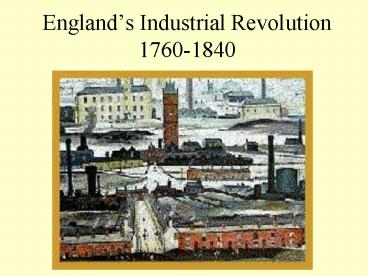Englands Industrial Revolution 17601840 - PowerPoint PPT Presentation
1 / 45
Title:
Englands Industrial Revolution 17601840
Description:
'Before the introduction of machinery, the spinning and weaving of ... Mule Spinning. Textiles by 1850. Lancashire factory. Women in the Industrial Revolution ... – PowerPoint PPT presentation
Number of Views:52
Avg rating:3.0/5.0
Title: Englands Industrial Revolution 17601840
1
Englands Industrial Revolution1760-1840
2
Why England?
Labor
Capital
Markets
3
Markets Overseas Empire
4
Agricultural Revolution
5
Enclosures the Birth of the Proletariat
6
Before,
7
And After
8
Tulls Seed Drill
9
Townsends Crop Rotation
10
(No Transcript)
11
Bakewells Scientific Breeding
12
Pre-Industrial Economy
The Domestic System
13
Friederick Engels, The Condition of the Working
Class in England
Before the introduction of machinery, the
spinning and weaving of raw materials was carried
on in the working man's home. Wife and daughter
spun the yarn that the father wove or that they
sold, if he did not work it up himself.
14
So the workers vegetated throughout a passably
comfortable existence, leading a righteous and
peaceful life . . . .
Their material position was far better than
that of their successors. They did not need to
overwork they did no more than they chose to do,
and yet earned what they needed. They had leisure
for healthful work in garden or field, work
which, in itself, was recreation for them.
15
Textiles lead the way in mechanization
16
Hargreaves Spinning Jenny, 1764
17
Cartwrights Power Loom, 1785
18
Whitneys Cotton Gin, 1793
19
Mule Spinning
20
Textiles by 1850
21
Lancashire factory
22
Women in the Industrial Revolution
23
Child Labor
24
Recap of Textile
25
The Coal Connection
26
Steam Power Newcomen Watt
27
Davys Safety Lamp, 1816
28
Steel
29
The Transportation Revolution MacAdams Roads
30
Steam Locomotives, 1801-1814
31
(No Transcript)
32
Canals
33
Fultons Steamboat, 1807
34
Impact on the Arts
J. M. W. Turners Rain, Steam and Speed, 1844,
National Gallery, London
35
Titanic
36
Faraday and Electricity, 1800
37
(No Transcript)
38
The Spread of Industrialism
39
(No Transcript)
40
(No Transcript)
41
Effects
42
Biological
43
Demographic
44
(No Transcript)
45
Endnotes
http//www.teachersfirst.com/lessons/inventor/ind-
rev-open.htm































